How far would you go to guard your coin collection?
Devon man Laurence Egerton decided to camp outside for THREE DAYS to protect his coins from potential thieves – however, he had just discovered the third largest hoard of Roman coins ever uncovered in the UK.
Almost 22,000 Roman coins from the reign of Emperor Constantine were discovered by the amateur metal detectorist in Seaton, East Devon. Now called the ‘Seaton Down Hoard’, it was declared treasure at a Devon Coroner’s inquest on Friday 12th September 2014.
His discovery is one of the biggest hoards of 4th century Roman coins to ever be recorded in Britain – after the Frome Hoard of 52,503 found in 2010, and 22,703 coins found in Dorset in 1989.
The copper alloy coins also happen to be one of the best preserved 4th century collections to have been excavated.
The asking price for the hoard will be decided by the British Museum’s Treasure Valuation Committee later this year, but it just goes to show, there could even be a Roman hoard in your back garden!
Roman Coin Offer
If you want to add a Roman coin to your collection right now, click here to secure a genuine issue from the reign of Claudius II Gothicus.
The 10 UK Coins that all collectors should own
For many people it’s difficult to know which coins they should own.
When I asked our UK Coin Specialist he selected the 10 coins below based on a combination of their numismatic interest, design excellence and accessible value. 10 coins that together are some of the most iconic British coins from the last 200 years.
They aren’t necessarily the best coins, but when brought together these coins create a comprehensive collection that is also affordable at under £500.
 1. William IV Silver Half Crown:
1. William IV Silver Half Crown:
Year of Issue: 1831 – 1837
This coin shares the design with one of the rarest Silver Crowns. During William IV’s reign Crowns were not issued for general circulation. But proofs and patterns were, and these are highly sought after. The obverse features the Bare Head portrait of William IV and the reverse design depicts a crowned shield on a mantle.
2. Queen Victoria Gothic Silver Florin: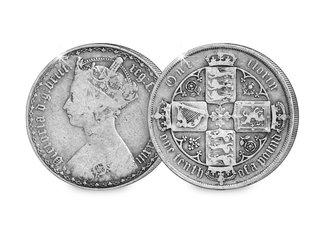
Year of Issue: 1851 – 1887
The Florin was first introduced in Queen Victoria’s reign as an early trial of decimal currency, 100 years ahead of its time. Although we are used to seeing a crowned monarch on our coinage, the portrait of Victoria wearing a crown was unusual to the general public and it was the first coin to feature a crowned monarch for over 200 years.
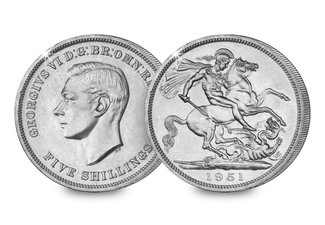 3. King George VI Crown:
3. King George VI Crown:
Year of Issue: 1951
Only two crowns were issued during the reign of King George VI. The Festival of Britain Crown was the first of these and also the first ever crown to be issued in cupronickel. The reverse of the crown features St. George slaying the Dragon, designed by Benedetto Pistrucci.
4. Queen Elizabeth II Silver Britannia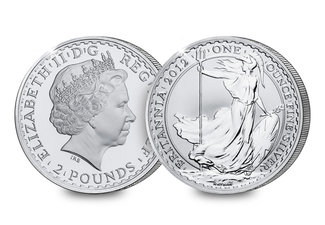
Year of Issue: 2012
Since its first issue in 1987 the 1oz Silver Britannia has become an annual staple for collectors. The Britannia reached its 25th anniversary in 2012 and to mark the occasion the original design by Philip Nathan featured on the reverse. It was also the last ever British coin to be struck from Britannia Silver (958/1000), a standard first introduced in 1696 Coinage Act.
 5. Hong Kong British Trade Dollar
5. Hong Kong British Trade Dollar
Year of Issue: 1895 – 1935
This coin was introduced in 1895 following China’s defeat in the Opium War. To ensure the acceptance of the dollar beyond British territories the design was given an Eastern look with the reverse featuring a Chinese labyrinth with the Chinese character ‘shou’ for longevity. It was demonetised in 1904, but continued to be minted until 1935.
6. Queen Victoria Britannia Penny: 
Year of Issue: 1839 – 1860
Despite being the longest reigning British Monarch, only three portraits were issued during Victoria’s reign. The first design – the Young Head – was the last penny to be struck from copper. In 1860 the switch was made from copper to bronze coinage. The reverse features a right facing seated Britannia holding a trident.
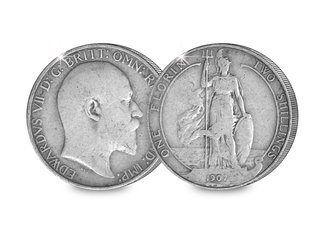 7. King Edward VII Silver Florin
7. King Edward VII Silver Florin
Year of Issue: 1902 – 1910
Designed by George William de Saulles, the Standing Britannia is considered by many to be one of the most attractive designs on British coins. It was unusual for a coin design to change so dramatically, especially because the coinage had been static for nearly 60 years during Victoria’s reign.
8. King George VI Silver Sixpence: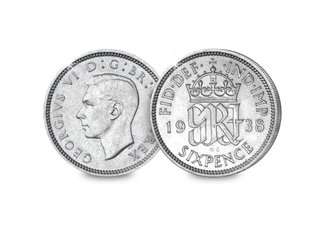
Year of Issue: 1937 – 1946
This was the last sixpence to be issued in silver. It has long been considered lucky. When the supply of threepence coins diminished, silver sixpences were used as a replacement in Christmas puddings. The RAF also use silver sixpences as good luck charm and have them sewn behind their wings or brevets, a custom that dates back to World War II.
 9. Queen Elizabeth II Coronation Crown:
9. Queen Elizabeth II Coronation Crown:
Year of Issue: 1953
This was the first commemorative coin issued during Queen Elizabeth II’s reign. It was never entered into general circulation, and as a result is highly sought after by collectors. Designed by Gilbert Ledward, the Crown features the Queen riding on horseback, which is unusual for a UK issue.
10. Queen Elizabeth II Britannia 50p: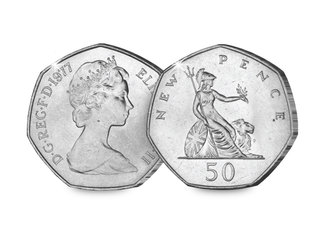
Year of Issue: 1969 – 1981
The world’s first 7-sided coin was introduced in 1969 to replace the 10 shilling note. The slight curved edges were designed to allow the coin to be used in vending machines without any problems. The obverse depicts Arnold Machin’s portrait of Queen Elizabeth II wearing the ‘Girls of Great Britain’ tiara.
These 10 coins are now available to own as a complete set.
Could this be the last ever Scottish 50p?
Scotland has long enjoyed good representation on UK currency, especially on the commemorative coins of the last 30 years.
But with the vote for Scottish independence looming, could this be the end for Scottish themes on coins used across the whole of Britain?
If so, the 50p just issued to mark the Glasgow Commonwealth Games would become the last ever Scottish 50p issued whilst the Union is still intact.
Firsts and lasts
Collectors know that ‘firsts’ and ‘lasts’ are often the most sought after issues. Sometimes this only becomes apparent in the years following the event – when the true importance of the coin is revealed.
With this in mind, the 2014 Glasgow Commonwealth Games 50p could be one of the most unintentionally important issues of the early 21st century.
You have to go back to 1707 to find the last pre-Union coins, struck during the reign of Queen Anne. These are now some of the most collectable issues of her reign, and usually the preserve of serious collections only.
So if you happen to be the owner of one of these 50ps, only time will tell how important it could become – regardless it’s a coin with a story of genuine national importance, and one that should definitely be considered for your collection.
If you are interested…
The Westminster Collection has a small number of these 50ps remaining from our Commonwealth Games commemorative range.
They are encapsulated and postmarked on the day of the closing ceremony, making them particularly limited. Click here for more information.





